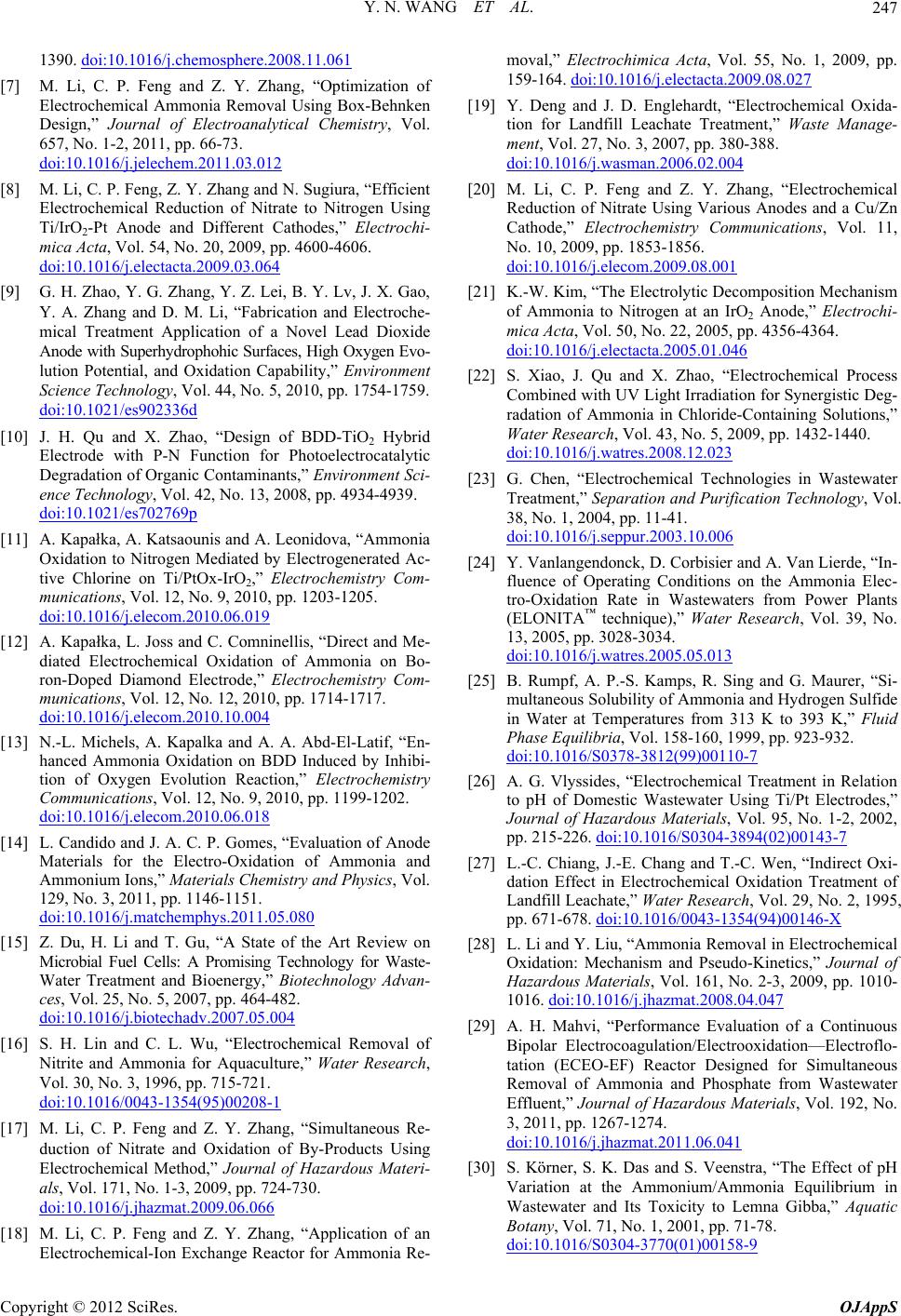
Y. N. WANG ET AL. 247
1390. doi:10.1016/j.chemosphere.2008.11.061
[7] M. Li, C. P. Feng and Z. Y. Zhang, “Optimization of
Electrochemical Ammonia Removal Using Box-Behnken
Design,” Journal of Electroanalytical Chemistry, Vol.
657, No. 1-2, 2011, pp. 66-73.
doi:10.1016/j.jelechem.2011.03.012
[8] M. Li, C. P. Feng, Z. Y. Zhang and N. Sugiura, “Efficient
Electrochemical Reduction of Nitrate to Nitrogen Using
Ti/IrO2-Pt Anode and Different Cathodes,” Electrochi-
mica Acta, Vol. 54, No. 20, 2009, pp. 4600-4606.
doi:10.1016/j.electacta.2009.03.064
[9] G. H. Zhao, Y. G. Zhang, Y. Z. Lei, B. Y. Lv, J. X. Gao,
Y. A. Zhang and D. M. Li, “Fabrication and Electroche-
mical Treatment Application of a Novel Lead Dioxide
Anode with Superhydrophohic Surfaces, High Oxygen Evo-
lution Potential, and Oxidation Capability,” Environment
Science Technology, Vol. 44, No. 5, 2010, pp. 1754-1759.
doi:10.1021/es902336d
[10] J. H. Qu and X. Zhao, “Design of BDD-TiO2 Hybrid
Electrode with P-N Function for Photoelectrocatalytic
Degradation of Organic Contaminants,” Environment Sci-
ence Technology, Vol. 42, No. 13, 2008, pp. 4934-4939.
doi:10.1021/es702769p
[11] A. Kapałka, A. Katsaounis and A. Leonidova, “Ammonia
Oxidation to Nitrogen Mediated by Electrogenerated Ac-
tive Chlorine on Ti/PtOx-IrO2,” Electrochemistry Com-
munications, Vol. 12, No. 9, 2010, pp. 1203-1205.
doi:10.1016/j.elecom.2010.06.019
[12] A. Kapałka, L. Joss and C. Comninellis, “Direct and Me-
diated Electrochemical Oxidation of Ammonia on Bo-
ron-Doped Diamond Electrode,” Electrochemistry Com-
munications, Vol. 12, No. 12, 2010, pp. 1714-1717.
doi:10.1016/j.elecom.2010.10.004
[13] N.-L. Michels, A. Kapalka and A. A. Abd-El-Latif, “En-
hanced Ammonia Oxidation on BDD Induced by Inhibi-
tion of Oxygen Evolution Reaction,” Electrochemistry
Communications, Vol. 12, No. 9, 2010, pp. 1199-1202.
doi:10.1016/j.elecom.2010.06.018
[14] L. Candido and J. A. C. P. Gomes, “Evaluation of Anode
Materials for the Electro-Oxidation of Ammonia and
Ammonium Ions,” Materials Chemistry and Physics, Vol.
129, No. 3, 2011, pp. 1146-1151.
doi:10.1016/j.matchemphys.2011.05.080
[15] Z. Du, H. Li and T. Gu, “A State of the Art Review on
Microbial Fuel Cells: A Promising Technology for Waste-
Water Treatment and Bioenergy,” Biotechnology Advan-
ces, Vol. 25, No. 5, 2007, pp. 464-482.
doi:10.1016/j.biotechadv.2007.05.004
[16] S. H. Lin and C. L. Wu, “Electrochemical Removal of
Nitrite and Ammonia for Aquaculture,” Water Research,
Vol. 30, No. 3, 1996, pp. 715-721.
doi:10.1016/0043-1354(95)00208-1
[17] M. Li, C. P. Feng and Z. Y. Zhang, “Simultaneous Re-
duction of Nitrate and Oxidation of By-Products Using
Electrochemical Method,” Journal of Hazardous Materi-
als, Vol. 171, No. 1-3, 2009, pp. 724-730.
doi:10.1016/j.jhazmat.2009.06.066
[18] M. Li, C. P. Feng and Z. Y. Zhang, “Application of an
Electrochemical-Ion Exchange Reactor for Ammonia Re-
moval,” Electrochimica Acta, Vol. 55, No. 1, 2009, pp.
159-164. doi:10.1016/j.electacta.2009.08.027
[19] Y. Deng and J. D. Englehardt, “Electrochemical Oxida-
tion for Landfill Leachate Treatment,” Waste Manage-
ment, Vol. 27, No. 3, 2007, pp. 380-388.
doi:10.1016/j.wasman.2006.02.004
[20] M. Li, C. P. Feng and Z. Y. Zhang, “Electrochemical
Reduction of Nitrate Using Various Anodes and a Cu/Zn
Cathode,” Electrochemistry Communications, Vol. 11,
No. 10, 2009, pp. 1853-1856.
doi:10.1016/j.elecom.2009.08.001
[21] K.-W. Kim, “The Electrolytic Decomposition Mechanism
of Ammonia to Nitrogen at an IrO2 Anode,” Electrochi-
mica Acta, Vol. 50, No. 22, 2005, pp. 4356-4364.
doi:10.1016/j.electacta.2005.01.046
[22] S. Xiao, J. Qu and X. Zhao, “Electrochemical Process
Combined with UV Light Irradiation for Synergistic Deg-
radation of Ammonia in Chloride-Containing Solutions,”
Water Research, Vol. 43, No. 5, 2009, pp. 1432-1440.
doi:10.1016/j.watres.2008.12.023
[23] G. Chen, “Electrochemical Technologies in Wastewater
Treatment,” Separation and Purification Technology, Vol.
38, No. 1, 2004, pp. 11-41.
doi:10.1016/j.seppur.2003.10.006
[24] Y. Vanlangendonck, D. Corbisier and A. Van Lierde, “In-
fluence of Operating Conditions on the Ammonia Elec-
tro-Oxidation Rate in Wastewaters from Power Plants
(ELONITA™ technique),” Water Research, Vol. 39, No.
13, 2005, pp. 3028-3034.
doi:10.1016/j.watres.2005.05.013
[25] B. Rumpf, A. P.-S. Kamps, R. Sing and G. Maurer, “Si-
multaneous Solubility of Ammonia and Hydrogen Sulfide
in Water at Temperatures from 313 K to 393 K,” Fluid
Phase Equilibria, Vol. 158-160, 1999, pp. 923-932.
doi:10.1016/S0378-3812(99)00110-7
[26] A. G. Vlyssides, “Electrochemical Treatment in Relation
to pH of Domestic Wastewater Using Ti/Pt Electrodes,”
Journal of Hazardous Materials, Vol. 95, No. 1-2, 2002,
pp. 215-226. doi:10.1016/S0304-3894(02)00143-7
[27] L.-C. Chiang, J.-E. Chang and T.-C. Wen, “Indirect Oxi-
dation Effect in Electrochemical Oxidation Treatment of
Landfill Leachate,” Water Research, Vol. 29, No. 2, 1995,
pp. 671-678. doi:10.1016/0043-1354(94)00146-X
[28] L. Li and Y. Liu, “Ammonia Removal in Electrochemical
Oxidation: Mechanism and Pseudo-Kinetics,” Journal of
Hazardous Materials, Vol. 161, No. 2-3, 2009, pp. 1010-
1016. doi:10.1016/j.jhazmat.2008.04.047
[29] A. H. Mahvi, “Performance Evaluation of a Continuous
Bipolar Electrocoagulation/Electrooxidation—Electroflo-
tation (ECEO-EF) Reactor Designed for Simultaneous
Removal of Ammonia and Phosphate from Wastewater
Effluent,” Journal of Hazardous Materials, Vol. 192, No.
3, 2011, pp. 1267-1274.
doi:10.1016/j.jhazmat.2011.06.041
[30] S. Körner, S. K. Das and S. Veenstra, “The Effect of pH
Variation at the Ammonium/Ammonia Equilibrium in
Wastewater and Its Toxicity to Lemna Gibba,” Aquatic
Botany, Vol. 71, No. 1, 2001, pp. 71-78.
doi:10.1016/S0304-3770(01)00158-9
Copyright © 2012 SciRes. OJAppS